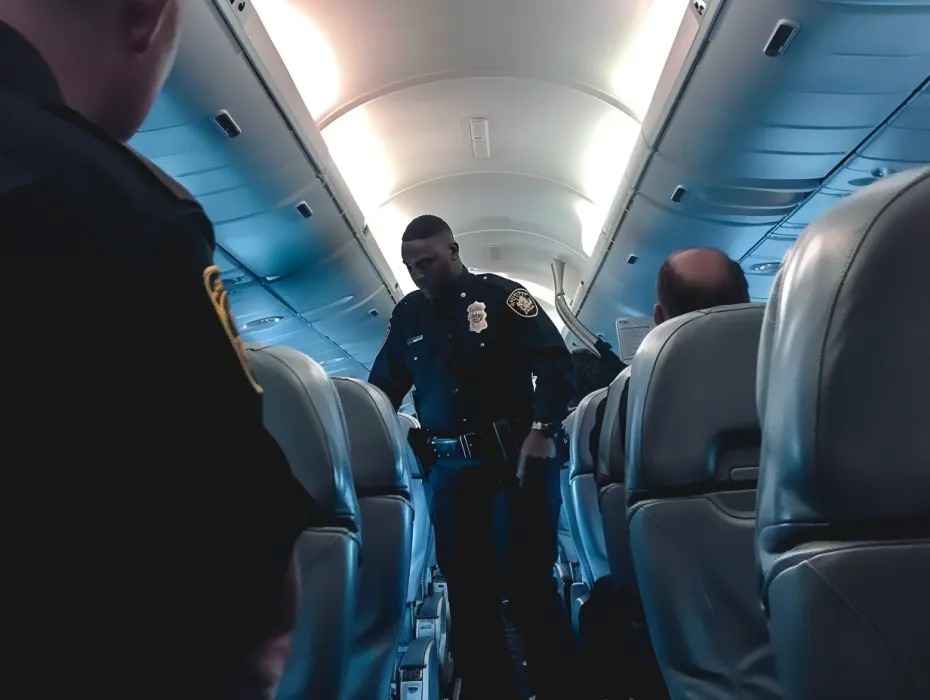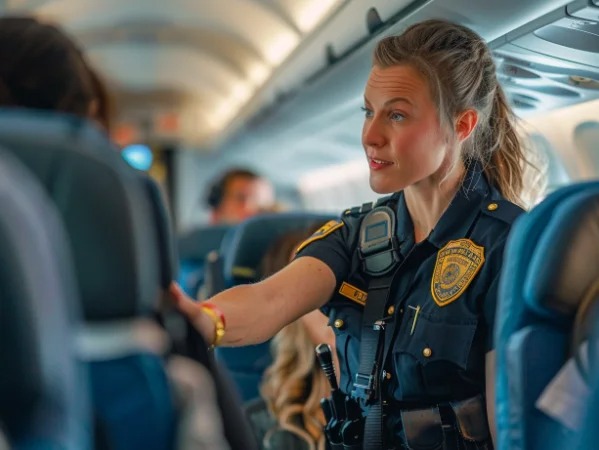As a flight attendant, Sandra had encountered all sorts of passengers—some friendly, some anxious, and a few who made her uneasy. But on this particular flight, something felt different. There was a woman on board who triggered an unsettling feeling in Sandra, a feeling she couldn’t ignore.

The moment the woman stepped onto the plane, Sandra’s intuition told her to pay close attention. There was something familiar yet inexplicably alarming about her presence. Was it her nervous energy? The way her eyes darted around the cabin? Or was it something deeper, something that connected to a past Sandra had tried to forget?
As Sandra continued with her duties, she couldn’t shake the feeling that something was wrong. The woman’s tense posture, her restless hands, and her subtle glances toward the man beside her painted a picture that didn’t sit well with Sandra. Who was he to her? And why did she seem so uneasy?
Little did Sandra know, this flight would challenge everything she thought she knew about instinct, judgment, and the fine line between vigilance and assumption.

Sandra was busy with pre-flight checks when she first noticed the woman. At first glance, she seemed like any other passenger—a young woman in her late twenties, dressed neatly but looking slightly tense. But as Sandra observed her more closely, she noticed something unusual.
The woman wasn’t just nervous; she was hyper-aware of her surroundings. Her eyes flickered too quickly across the cabin, as if scanning for something—or someone. Her hands were never still, adjusting her purse, smoothing her hair, or gripping the armrest with visible tension.

When she took her seat next to an older man, Sandra instinctively paid closer attention. He seemed composed, authoritative, and very much in control. He chose their seats, answered for her when a flight attendant asked if they needed anything, and ordered drinks—beer for himself and water for her.
Something about their dynamic didn’t feel right. The woman’s body language screamed discomfort, yet she said nothing. Sandra’s instincts kicked in—was she in trouble?
Determined to observe them more closely, Sandra hoped to serve drinks in their section. But luck wasn’t on her side—another crew member had already taken that aisle.

Her colleague Harper, noticing her distraction, playfully teased her about being interested in someone sitting there. Sandra quickly brushed it off, making up an excuse about liking the number two. But her real reason was far more serious—she needed to understand what was going on with this woman.
As she continued working, Sandra’s eyes kept drifting toward the woman and the man beside her. The woman’s unease didn’t seem to fade. In fact, as the flight went on, it only seemed to grow.
Sandra decided she needed a plan. She would wait for the perfect moment—when the man left his seat—to approach the woman and see if she needed help.

Hours passed, and Sandra’s patience was wearing thin. Then, finally, the man got up to use the restroom. This was her chance.
Sandra quickly grabbed a pen and a small piece of paper, making her approach appear casual. “I think this might be yours,” she said softly, placing the pen down in front of the woman. Then, in a whisper, she added, “If you need anything, feel free to write it down.”

She watched closely, hoping for any sign of recognition or response. But before the woman could react, the man returned. His eyes immediately landed on the pen and paper. He looked at the woman, then at Sandra, his gaze sharp and questioning.
Sandra’s heart pounded. She had hoped to help, but now she had only drawn unwanted attention.
The woman quickly averted her eyes, as if afraid to acknowledge Sandra’s attempt to communicate. Sandra forced a smile at the man, making a lighthearted excuse about returning a lost pen before retreating back to the galley.

As she stood there, trying to process what had just happened, she realized something: The woman had been making small hand gestures. Subtle movements, but deliberate. It wasn’t random fidgeting—it was a silent message.
And then, it clicked.

Sandra remembered learning about a universal hand signal for help—a thumb tucked into the palm, covered by closing fingers. It was a discreet way for someone in danger to signal distress without speaking.
She had once needed that very same sign herself. And when she used it, no one noticed.
Now, here was someone else using it—on Sandra’s watch. And she refused to let history repeat itself.
Sandra knew she had to act, but she needed to be smart. She confided in her colleague Charlotte, explaining her concerns about the woman’s behavior and the distress signal she had recognized.
Charlotte listened, concerned but cautious. “We need to be sure before we do anything,” she said. “Let’s keep watching.”

Sandra reluctantly agreed. But deep down, she already knew—this woman needed help.
Then, suddenly, a scream shattered the quiet of the flight.
Passengers turned their heads. Sandra and Charlotte immediately locked eyes. Without hesitation, they rushed toward the woman’s seat.

The woman was visibly distressed, trying to move away from the man beside her. Sandra stepped in, her voice firm. “Leave her alone.”
The man’s response was defensive. “She’s just afraid of turbulence,” he insisted. But Sandra wasn’t convinced.
Determined to escalate the matter, Sandra discreetly contacted the airport’s emergency services. “We need authorities at the gate when we land,” she said urgently. “Something isn’t right.”
She knew she was taking a risk. But if there was even a chance that this woman needed help, she had to act.
As soon as the plane landed, uniformed officers boarded. The tension in the cabin was palpable as they approached the man and the woman.

“Sir, we need to speak with you,” one officer said.
The man’s expression shifted from surprise to irritation. “This is a mistake,” he protested. “She’s with me.”

Sandra held her breath, watching as the officers carefully assessed the situation. Then, something unexpected happened.
The man calmly handed over his identification and said, “She’s my daughter.”

Sandra froze.
“She has autism,” he explained. “The hand signals are part of a system we developed to help her communicate when she feels overwhelmed.”
The officers hesitated, glancing at the woman. She nodded in confirmation, her expression still tense but less fearful than before.
Sandra felt her stomach drop. Had she made a terrible mistake?
As the situation de-escalated, the officers confirmed the man’s story. The woman, though anxious, was not in danger. The hand signals, which Sandra had interpreted as a plea for help, were actually part of her way of coping with social situations.

Sandra’s heart sank. She had acted out of concern, but in doing so, she had wrongly assumed the worst.
She approached the man and his daughter, her voice filled with remorse. “I’m so sorry. I misread the situation.”
To her surprise, the man wasn’t angry. “You were looking out for her,” he said. “I appreciate that.”
The woman, still a bit shaken, gave Sandra a small smile. It wasn’t resentment in her eyes—it was understanding.
As they exited the plane, Sandra was left with a whirlwind of emotions. Relief. Embarrassment. And above all, the realization that vigilance must always be balanced with understanding.
She had tried to help. And while this time she had been mistaken, she knew she would always rather be cautious than overlook someone truly in danger.

As she prepared for her next flight, she carried that lesson with her. A reminder that every person has a story—and that the role of a flight attendant goes beyond service. It’s about care, empathy, and learning when to step in—and when to step back.
Because sometimes, the real lesson isn’t just about taking action. It’s about knowing when to listen.
Leave a Reply